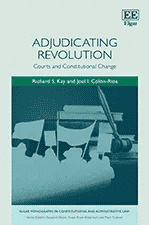Adjudicating Revolution: Courts and Constitutional Change
September 23, 2022

Edward Elgar has published Adjudicating Revolution: Courts and Constitutional Change by Richard S. Kay and Joel Colon-Rios. The book is a comparative study of eight jurisdictions in which courts have been called on to render judgments on the legality of a revolutionary regime, one that has established itself in violation of governing constitutional rules.
In its introductory chapter (which the publisher has made available online, https://www.elgaronline.com/download/pdf/book/9781788971331/book-part-9781788971331-6.xml), the book sets out the paradoxical nature of such litigation. In ordinary discourse, the act of revolution, by definition displaces the authority of prior law. What law then are courts supposed to apply in adjudicating the revolution’s legality? Still, as the authors demonstrate, the decisions in several jurisdictions have coalesced around a few common doctrines. These include the judicial recognition of de facto governments, an approach apparently motivated by the need to maintain some level of public order. The same considerations underlie judgments that accord legal status to acts on the basis of social “necessity.” A final “law” of revolutionary change focuses on the existence of conditions demonstrating that the underlying assumptions of a legal system have undergone a fundamental and permanent alteration. Several of the courts confronting such a claim have relied on the theoretical work of Hans Kelsen. They undertake an examination of whether or not a jurisdiction’s Basic Norm has been replaced. This usually boils down to an evaluation of the extent to which the new government has been firmly established and whether its policy choices have been effective.
These doctrinal devices have been frequently employed by courts in cases where individuals have challenged the acts of revolutionary governments. The exact way in which they have been used differs depending on the historical, social and legal context in the particular jurisdiction involved. The remaining eight chapters each consist of an intensive examination of judicial actions in a particular regime that had undergone or was undergoing revolutionary change. In two of the situations studied, the Confederate States and the Rhodesian Republic, the law-breaking state’s institutions were short lived. In the former, the prior legal system, that of the United States, was restored in the rebellious southern states. In the latter, a brief transitional restoration of British colonial authority was followed by the inauguration of a new legal system based on universal suffrage.
In another chapter, that dealing with Spain and Catalonia, the “revolution” that was the subject of judicial scrutiny was still a hypothetical one. In these three situations, it may have been relatively easier for courts to evaluate the revolutionary movement against the rules of the constitutional state against which it had been launched since, at the time of decision, that legal state, at least in some form, was still up and functioning. When the Judicial Committee of the Privy Council was confronted with a situation in which the rebellious Rhodesian government was in full control of the territory in Africa, it was still able to resist the conclusion that a successful revolution had taken place by noting that the legal government of the United Kingdom (of which, of course, the Privy Council was itself an agency) was “taking steps to regain control and it is impossible to predict with certainty whether or not it will succeed.” When this judgment failed to move the rebellious government, however, things looked different to the courts on the ground in Rhodesia, who finally acknowledged that a new de jure state had been successfully established. The Constitutional Court of Spain, when adjudicating the legality of a hypothetical independent Catalonian state, may well have seen itself as in a similar position as the Privy Council in the Rhodesia case. That Court sat in Madrid and again, it was a part of a legal system that was effective and fully functioning. Strict legality according to the Spanish legal system must have seemed to be the natural, if not the inevitable course.
The other five chapters, examine instances of post-revolutionary adjudication in Argentina, Colombia, Grenada, Peru and Fiji. They deal with cases in which the courts were confronted with a rather different situation. In each the new revolutionary governments were, to various extents, successfully governing the respective territories. In such cases, judges may rationally decide that application of the law of the ousted state would be an exercise in irrelevance. They have, therefore, usually called on the doctrines of necessity or de facto government to provide a justification for recognizing the reality of the political situation while, at the same time, clothing the new regime with legal or at least legalistic authority. While the basic frameworks of these doctrines are the same in all the cases studies, their application both at the time of revolution and in the period following it exhibit different characteristics depending among other things on prevailing attitudes towards the previous government and attachment to “the rule of law.” In addition to a close analysis of the judicial decision each chapter follows the subsequent events in each jurisdiction and how the judicial intervention influenced – or failed to influence—the constitutional system.
